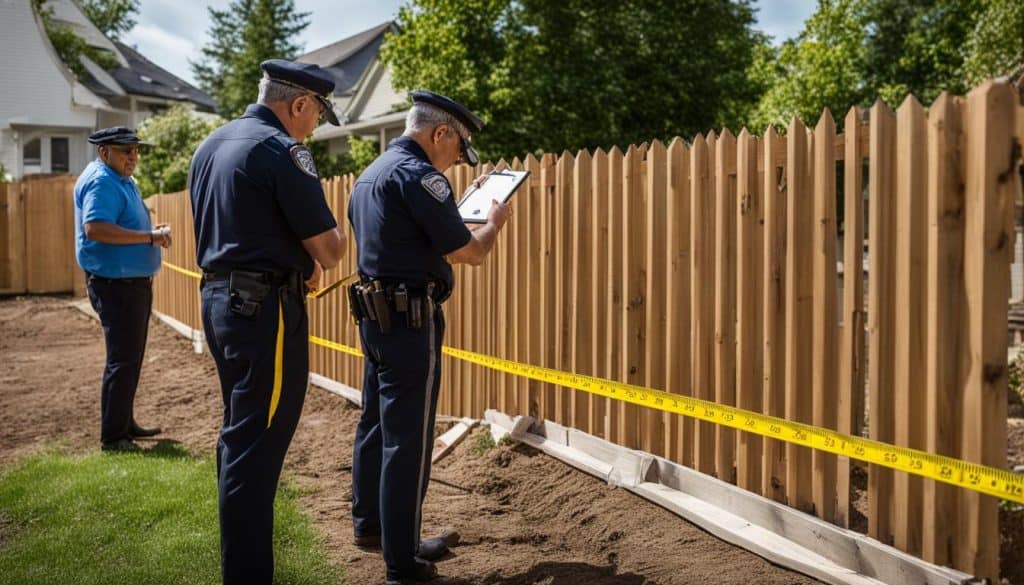If you are planning to install a fence, it’s essential to understand the specific requirements and regulations that govern the need for a fence permit. Failing to obtain the necessary permit can lead to legal and financial repercussions. Local authorities regulate fence installation to ensure the safety, privacy, and aesthetics of the neighborhood.
Fence permit requirements:
- Fences on residential properties typically require a permit if they exceed six feet in height, while commercial properties may have different requirements, depending on the location and intended use.
- Before installing a fence, you must get clearance from local zoning and code enforcement offices, as well as obtain a building permit.
- Depending on the area, there may be specific regulations for fence placement, such as setbacks from property lines, roads, or sidewalks.
- Some areas may also require homeowners to get written consent from their neighbors before installing a fence.
It’s crucial to check with your local authorities to ensure that you comply with all relevant fence installation regulations. Failure to comply may result in fines, lawsuits, or even the removal of the fence.
“Before installing a fence, you must get clearance from local zoning and code enforcement offices, as well as obtain a building permit.”
Height Restrictions and Location Guidelines
Most areas have specific height restrictions for fences, with six feet being the typical maximum height allowed on residential properties. Some jurisdictions may allow taller fences for specific purposes, such as providing a higher level of security or privacy. Additionally, placement guidelines, such as setbacks from property lines, roads, or sidewalks, help ensure that fences don’t create hazards or obstruct views for drivers or pedestrians.
Fence Building Codes
When it comes to fence installation, building codes are in place to ensure that safety and functionality standards are met. Failure to adhere to building codes can result in unsafe and unstable installations, which can be costly to repair or replace. Therefore, it is important to have a clear understanding of the relevant building codes before proceeding with your fence installation.
There are several key building codes that may apply to your fence installation, including:
- The International Building Code (IBC)
- The International Residential Code (IRC)
- The National Electric Code (NEC)
- The Americans with Disabilities Act (ADA)
The IBC applies to commercial properties, while the IRC applies to residential properties. The NEC sets standards for electrical components and grounding for fences that are near power lines. The ADA focuses on accessibility for individuals with disabilities.
Building Code Requirements
The specific requirements set by building codes may vary depending on the type and location of the fence, as well as the materials used in its construction. For example, the IBC sets minimum post depth and footing size requirements based on the height and size of the fence. The IRC requires that fences be set back from the property line, and have a maximum height of six feet for backyard fences.
Other requirements may include:
- Minimum fence height for privacy or security purposes
- Maximum fence height for visibility or aesthetic reasons
- Minimum distance between fence posts
- Minimum fence post size and depth
- Proper anchoring and bracing to withstand wind and weather conditions
- Proper clearance between the fence and the ground or adjacent structures
- Proper installation of gates or entryways to ensure safe operation
It is important to note that building codes may vary based on the state and local jurisdiction. Always check with your local authorities to ensure that your fence installation meets the necessary building codes and regulations.
“Adhering to building codes is not only a legal requirement, but it also ensures the safety and functionality of your fence installation.”
Obtaining a Fence Permit
Applying for a fence permit can seem like a daunting task, but with the right information, the process can be straightforward. The following steps will guide you through the fence permit application process:
- Determine whether your fence installation requires a permit. This will depend on the specific regulations set by your local authorities, such as height restrictions and location guidelines.
- Contact your local building department to obtain the necessary application forms and documentation requirements. This may include a fence plan, property survey, and zoning and building permits.
- Fill out the application forms accurately and completely. Be sure to include all required documentation and pay any necessary fees.
- Submit the application to the building department, either in person or online, depending on the available options.
- Wait for approval. The timeline for approval will vary depending on your local authorities and the specifics of your application. If your application is denied, you may have the opportunity to make necessary changes and reapply.
It is important to note that failure to obtain a fence permit when required can result in fines or legal action. To avoid any complications, it is best to consult with your local authorities and follow all necessary procedures to obtain the required permit for your project.
It may also be helpful to hire a professional fence installer who is familiar with the permit application process and can assist you in obtaining the necessary documentation.
“Obtaining a permit can seem like a lot of work, but it is important to ensure that your fence is legally compliant, safe, and functional. Following the necessary procedures can save you time, money, and headaches down the road.”
Fence Permit Cost
When planning for a fence installation project, it’s essential to consider the associated costs of obtaining a fence permit. The process of obtaining a permit can incur various fees, depending on the area of your property and the type of fence you’re building. Understanding the cost of obtaining a permit is crucial in ensuring your project stays within budget and follows the necessary regulations. The cost of a fence permit varies significantly depending on various factors such as location, type of fence, and the size of the project.
It’s important to note that permit fees are non-refundable, even if your application does not get approved. Before submitting your application, ensure that you have met all requirements and submitted all necessary documents to avoid delays or additional costs.
Remember that complying with permit regulations is crucial to ensure the safety and functionality of your fence. Failing to follow the regulations can lead to fines or penalties, which may incur more cost in the long run. Always consult with your local authorities and obtain the necessary permits before commencing any fence installation project.
Local Fence Permit Guidelines
When undertaking a fence installation project, it is important to understand the specific regulations and guidelines set by your local jurisdiction. These guidelines can vary depending on your location, so it’s essential to check with your local authorities before beginning your project.
Height restrictions are a common factor in local fence permit guidelines. In many cases, fences cannot exceed a certain height, usually between 4 and 6 feet, depending on the area and the type of fence.
Location guidelines are another important consideration. Fences may need to be set back a certain distance from property lines or roadways. In some cases, your local jurisdiction may require that you obtain a permit for a fence that is located near a public right-of-way or utility easement.
Some areas may have specific requirements for the type of material used in your fence, such as wood, vinyl, or chain link. Additionally, you may need to obtain a separate permit for any gates—back, front yard gates, or other entryways in your fence.
Residential Fence Permit
When planning to install a fence on your residential property, it is important to obtain the necessary permits to ensure compliance with local regulations. In this section, we will discuss the specific requirements and considerations for obtaining a residential fence permit.
Height and Location Restrictions
One of the most important factors when applying for a residential fence permit is ensuring compliance with height and location restrictions. These restrictions vary by jurisdiction, but typically mandate limits on fence height and distance from the property lines.
For example, in the city of Los Angeles, fences in the front yard cannot exceed 42 inches in height, while those in the backyard cannot exceed 6 feet. Fences are also required to be at least 2 feet away from the sidewalk and property line.
It is important to consult with your local authorities to understand the specific requirements for your area and ensure that your fence design meets these guidelines.
Materials and Fence Design
Residential fence permits may also require that the fence materials and design meet certain standards. For example, some jurisdictions may require that fences be constructed of specific materials, such as wood or vinyl.
Additionally, some localities may require that the fence design be aesthetically pleasing and complementary to the surrounding neighborhood. This may include restrictions on the color, style, and placement of the fence.
Fence Permit Application Process
The process for obtaining a residential fence permit varies by jurisdiction, but typically involves submitting an application and accompanying documentation to the local building department. This may include a detailed site plan, a drawing of the proposed fence design, and a fee payment for the permit.
It is important to carefully review the permit application requirements and ensure that all necessary information and supporting documents are provided to avoid delays or rejection of the application.
Commercial Fence Permit
When it comes to obtaining a fence permit for a commercial property, there are several important considerations to keep in mind. Most local jurisdictions have additional regulations and guidelines that businesses need to adhere to in order to ensure safety and compliance.
Height and Location Restrictions
Commercial properties may face more stringent height and location restrictions than residential properties. Some jurisdictions may limit the maximum height of a fence or specify where it can be placed on the property. It is important to check with your local authorities to ensure that your fence plans comply with all height and location restrictions.
Materials Used
The materials used for a commercial fence may also be subject to specific regulations. For example, some jurisdictions may prohibit the use of barbed wire or electric fences in certain areas. Additionally, certain fencing materials may require a fire safety rating or be subject to other safety regulations.
Permit Application Process
Obtaining a commercial fence permit typically requires a detailed application process. In addition to providing information about the location and design of the fence, you may be required to submit documentation such as a site plan or building permit. It is important to carefully review all requirements and submit a complete application to ensure a timely approval process.
Costs and Fees
The cost of a commercial fence permit can vary depending on the jurisdiction and the scope of the project. In addition to the permit fee, there may be additional costs associated with inspections or other requirements. It is important to budget for these costs when planning your fence installation project.
Consult with Professionals
To ensure compliance with all regulations and guidelines for commercial fence installation, it is advisable to consult with experienced professionals such as fence contractors or building inspectors. They can provide valuable guidance and insights to help streamline the process and ensure a successful outcome.
Overall, obtaining a commercial fence permit can be a complex process. However, by understanding the specific regulations and guidelines in your area and working with experienced professionals, you can ensure that your fence installation project is completed safely, efficiently, and in compliance with all applicable regulations.
Conclusion
Understanding whether you need a fence permit is a crucial step in ensuring a smooth and compliant project. As you navigate the intricacies of local regulations, it’s essential to partner with a trusted and experienced team to guide you through the process.
At Los Angeles Fencing Co., we specialize in providing not just fences, but solutions that align with local requirements and enhance the beauty of your property. Whether you’re considering a new wood fence or any other fencing project, our experts are here to help. Secure your property with style and compliance – choose Los Angeles Fencing Co. for unparalleled expertise and craftsmanship. Your dream fence is just a click away!



